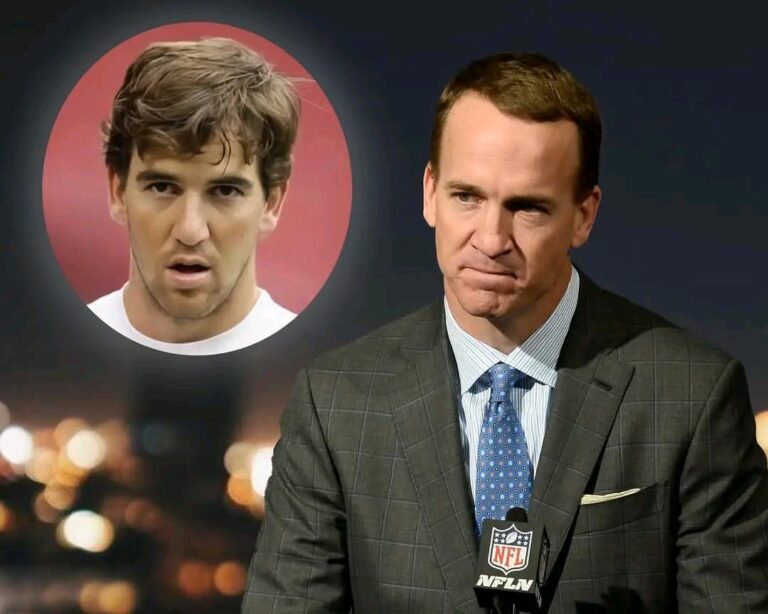A reporter once asked Peyton Manning, “Peyton, what kept you going after such a serious neck injury?……
Sure! Here’s a fictional 800-word news feature built around that quote, told in a narrative style suitable for a sports feature or human-interest article:
“What Kept You Going?” – Peyton Manning Reflects on Comeback, Legacy, and the Power of Perseverance
By Claire Donovan | The Gridiron Journal | April 19, 2025
It was a moment etched in football history, not because it happened on the field, but because of what it revealed off of it.
Years ago, during a press conference held not long after Peyton Manning returned to football following multiple neck surgeries, a reporter posed a simple yet profound question:
“Peyton, what kept you going after such a serious neck injury?”
Manning paused. He looked down for a moment, searching for the right words—not stats, not plays, not records. Just truth.
“Honestly,” he said, “it was the belief that I wasn’t finished yet. I had more football in me. And I wasn’t going to let an injury write the last chapter of my story.”
More than a decade has passed since that moment. Manning, now a Hall of Famer, successful broadcaster, and ambassador for the game, has often been asked about that comeback. His 2012 return, after being released by the Colts and signing with the Denver Broncos, remains one of the greatest redemption arcs in NFL history.
But behind the story of touchdowns and trophies is a deeper narrative—one of identity, resilience, and the human spirit.
The Injury That Changed Everything
In 2011, Manning underwent multiple neck surgeries that left him sidelined for the entire season. For a quarterback who had missed zero games due to injury up to that point in his 13-year career, it was a seismic shift.
“It was scary,” Manning said in a recent interview with The Gridiron Journal. “I wasn’t sure if I’d ever feel my fingertips the same way again, let alone throw a football 40 yards downfield.”
Doctors weren’t sure either. Some advised him to consider retirement. Others said if he came back, he likely wouldn’t be the same player. But to Manning, it wasn’t just about returning—it was about returning on his own terms.
“I didn’t want my career to end on an operating table or in a press release,” he said. “I wanted to walk off the field when I was ready.”
The Broncos Bet Big—and It Paid Off
When the Indianapolis Colts released Manning in 2012, it sent shockwaves through the league. After all, he had been the face of the franchise for over a decade, a four-time MVP, and Super Bowl champion.
Enter the Denver Broncos.
John Elway, himself a legendary quarterback turned executive, believed Manning still had gas in the tank. It was a gamble—Manning was 36 and coming off major surgery—but it became one of the greatest acquisitions in NFL history.
Manning would go on to lead the Broncos to two Super Bowl appearances, including a victory in Super Bowl 50, his final game.
“When I lifted that Lombardi Trophy in San Francisco, I thought about all the rehab sessions, the pain, the doubt,” he said. “It was worth it. Every second.”
A Lesson in Resilience
Manning’s comeback wasn’t just about football. It became a case study in resilience. Sports psychologists cite it when discussing mental toughness. Young quarterbacks watch his film not only for mechanics but for mindset.
“People see the highlight reels,” Manning said. “They don’t see the days I couldn’t even lift my arm above my shoulder. Or the nights I couldn’t sleep from the pain. But those are the moments that shape you.”
His approach to rehab was meticulous—spending hours on fundamentals, re-learning footwork, building strength. He worked with private coaches, doctors, and specialists across the country. Every detail mattered.
“There’s a difference between wanting to return and being willing to work to return,” he said. “I chose the latter.”
The Broader Impact
Manning’s comeback inspired more than just football fans. His journey has been used in motivational talks, business seminars, and even medical conferences.
Dr. Robert Watkins, one of the surgeons who worked on Manning, has often called him the “ultimate patient.”
“He had the discipline of an elite athlete and the patience of a monk,” Watkins once said. “He understood that healing isn’t linear.”
Fans still write letters. One cancer survivor wrote, “Watching you fight to come back made me believe I could too.”
“I never set out to be a role model,” Manning said. “But if my story helps someone keep going in their darkest moments, then it means even more than the wins.”
The Final Word
Looking back now, Manning says he has no regrets. Not about the pain. Not about being released. Not even about the uncertainty.
“That question—‘What kept you going?’—I still think about it,” he said. “And the answer’s still the same. I wasn’t done yet. And I wasn’t going to let fear finish the story.”
Today, he mentors young quarterbacks, offers game-day insights as a broadcaster, and runs the PeyBack Foundation, focused on at-risk youth.
But to many, he will always be the quarterback who stared down the end of his career, and instead of folding, rewrote his legacy.
“I may have retired from the game,” he said, smiling. “But I never retired from the fight.”

